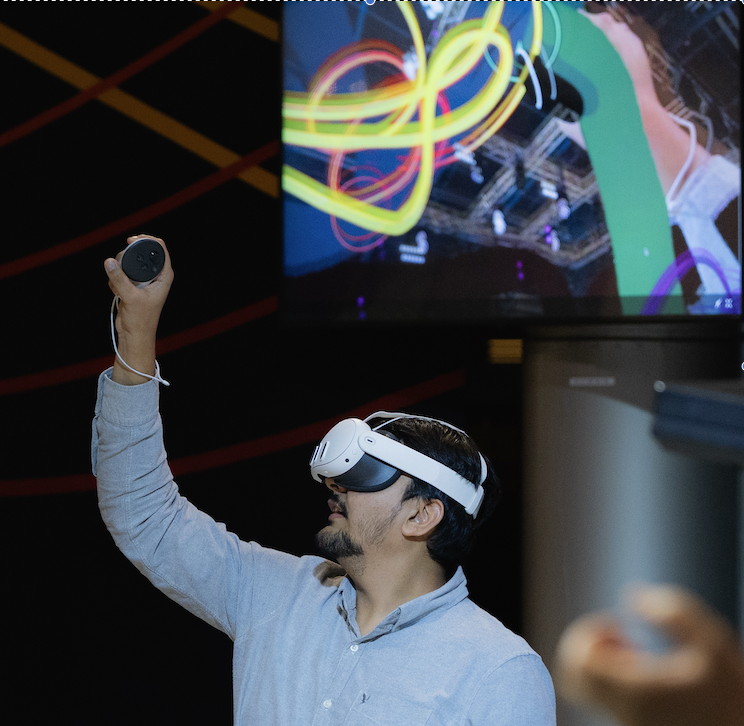- Academics
- Admissions
- Enrollment & Registration
- Research
- Academic & Creative Spaces
- Strategic Partnerships
- Our Impact
- Student Affairs
- Alumni
- About VCUarts Qatar
- Community & Continuing Education
ADMISSIONS FOR FALL 2025 NOW OPEN
Immersive Futures: VR, AR, and XR Across Industries
Categories

In 2017, when I first put on a Virtual Reality (VR) headset and began designing in a virtual digital space, the experience felt strangely familiar. It was less like learning something new and more like remembering a language I had always known. Creating in VR felt more natural than sketching on paper or working with a 3D program on a flat screen.
Building on this personal experience, neuroscience offers a scientific explanation. The Blue Brain Project discovered that networks of neurons form geometric structures in three-dimensional contexts, sometimes in up to eleven dimensions (Reimann et al., 2017; Wired, 2017). These findings show that memory and thought are deeply spatial, explaining why VR, AR, and XR feel intuitive rather than foreign.
Beyond science, industry research confirms the broader value of immersive tools. HTC Vive reports that 70% of clients better understand designs in VR. And from an economic perspective, immersive tools can reduce prototyping costs by up to 25%. ABI Research estimates XR can lower project expenses by 12%, while PwC projects it could contribute USD 1.5 trillion to the global economy by 2030. The market itself is expected to exceed USD 2 trillion (Grand View Research, 2023; MarketsandMarkets, 2024).
These economic projections are already visible through practical applications. In architecture, clients walk through buildings before construction, reducing waste. In healthcare, surgeons rehearse procedures in simulations, improving safety. Manufacturers refine prototypes digitally, while in education, students ste inside molecules, planets, or historical events. Beyond this, XR also enables new cultural and social interactions. Albarazy’s (2022) research on the MetaMosque shows how virtual environments can act as public spaces, extending communal life into the digital realm.
At the regional level, Qatar has embraced these opportunities. Institutions such as Qatar Museums and the 3-2-1 Olympic & Sports Museum use VR and AR to merge heritage with innovation (Gulf Magazine, 2023). Healthcare simulation labs train professionals in safe environments, while universities integrate immersive tools to prepare graduates for the digital economy (Microsoft, 2023). These initiatives align with Qatar National Vision 2030. On a more personal scale, smartphones illustrate how seamlessly technology integrates into daily life. They act like vital organs—always in hand, guiding how we see and remember. Their cameras serve as new eyes, while apps fuel economies (Ward et al., 2017). XR is simply the next step: not looking through a device, but
stepping inside it. However, one critical obstacle remains: talent. Many organizations own the hardware but lack professionals who can apply it. This is where the Introduction to Design in Virtual Reality course plays a role. Using tools like Tilt Brush and Gravity Sketch, participants design immersive environments and artworks showcased on international stages. Beyond technical skills, the course develops design thinking and leadership, both critical for guiding XR adoption.
Looking ahead, the convergence of XR with AI, cloud systems, and advanced sensors will blur the boundary between the physical and digital worlds even further. From smart factories and virtual hospitals to immersive classrooms and interactive museums, the opportunities are immense. For Qatar, embracing XR means not only keeping pace but setting the pace. For professionals worldwide, the message is clear: mastering immersive technologies today is key to shaping tomorrow. Spatial computing, as Albarazy notes, “is a language everyone must learn to speak” (Albarazy, 2022).
Alaa Albarazy is a designer, educator, and researcher whose work focuses on how immersive technologies influence culture and learning. Through his teaching, publications, and exhibitions, he advocates for the integration of spatial computing into design education and practice.
He will be leading the upcoming course “Introduction to Designing in Virtual Reality,” offered through the VCUarts Qatar Continuing Education Program. This hands-on course equips participants with practical VR design skills while encouraging creative problem-solving and leadership in immersive technology.
The VCUarts Qatar Continuing Education Program provides a wide range of specialized courses in Design Technology, Leadership in Design, Business in Design, Entrepreneurship in Design, and Art Management. These programs are designed to empower artists, designers, and professionals to expand their expertise and succeed in today’s evolving creative industries.

